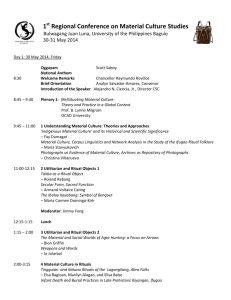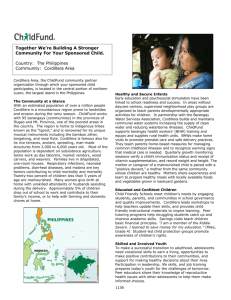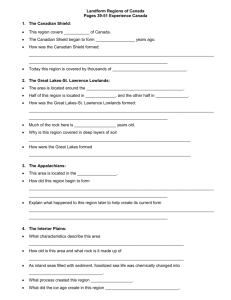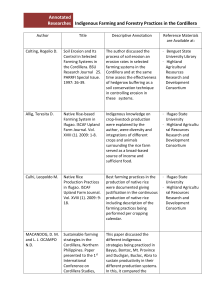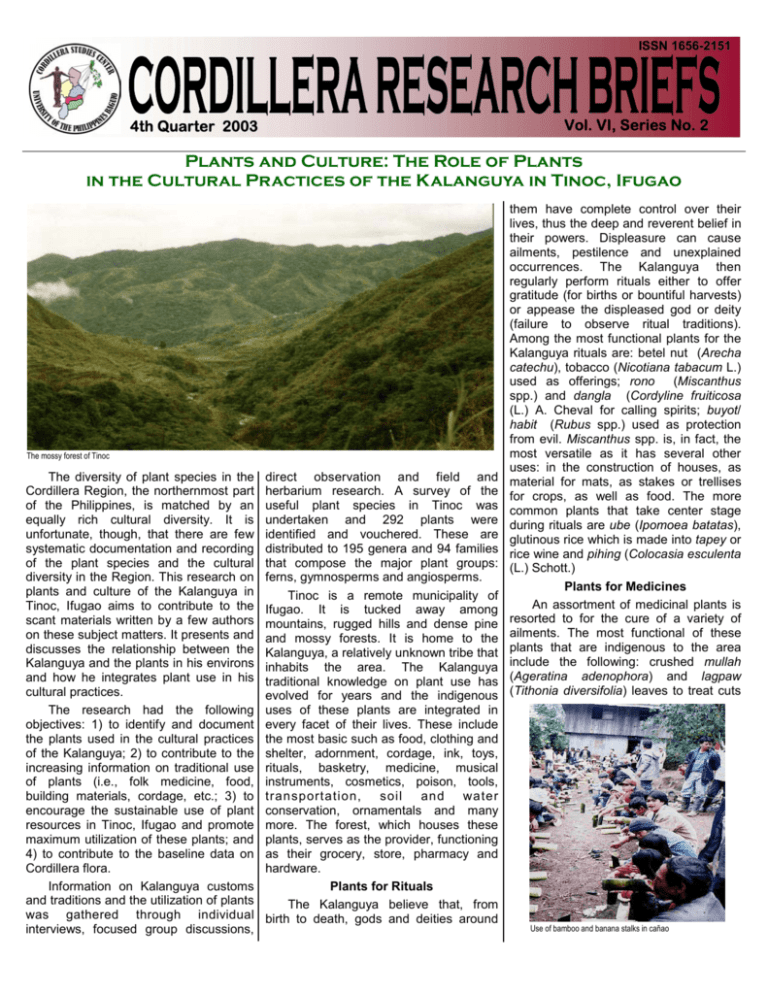
ISSN 1656-2151
Vol. VI, Series No. 2
4th Quarter 2003
Plants and Culture: The Role of Plants
in the Cultural Practices of the Kalanguya in Tinoc, Ifugao
The mossy forest of Tinoc
The diversity of plant species in the
Cordillera Region, the northernmost part
of the Philippines, is matched by an
equally rich cultural diversity. It is
unfortunate, though, that there are few
systematic documentation and recording
of the plant species and the cultural
diversity in the Region. This research on
plants and culture of the Kalanguya in
Tinoc, Ifugao aims to contribute to the
scant materials written by a few authors
on these subject matters. It presents and
discusses the relationship between the
Kalanguya and the plants in his environs
and how he integrates plant use in his
cultural practices.
The research had the following
objectives: 1) to identify and document
the plants used in the cultural practices
of the Kalanguya; 2) to contribute to the
increasing information on traditional use
of plants (i.e., folk medicine, food,
building materials, cordage, etc.; 3) to
encourage the sustainable use of plant
resources in Tinoc, Ifugao and promote
maximum utilization of these plants; and
4) to contribute to the baseline data on
Cordillera flora.
Information on Kalanguya customs
and traditions and the utilization of plants
was gathered through individual
interviews, focused group discussions,
direct observation and field and
herbarium research. A survey of the
useful plant species in Tinoc was
undertaken and 292 plants were
identified and vouchered. These are
distributed to 195 genera and 94 families
that compose the major plant groups:
ferns, gymnosperms and angiosperms.
Tinoc is a remote municipality of
Ifugao. It is tucked away among
mountains, rugged hills and dense pine
and mossy forests. It is home to the
Kalanguya, a relatively unknown tribe that
inhabits the area. The Kalanguya
traditional knowledge on plant use has
evolved for years and the indigenous
uses of these plants are integrated in
every facet of their lives. These include
the most basic such as food, clothing and
shelter, adornment, cordage, ink, toys,
rituals, basketry, medicine, musical
instruments, cosmetics, poison, tools,
transportation, soil
and
water
conservation, ornamentals and many
more. The forest, which houses these
plants, serves as the provider, functioning
as their grocery, store, pharmacy and
hardware.
Plants for Rituals
The Kalanguya believe that, from
birth to death, gods and deities around
them have complete control over their
lives, thus the deep and reverent belief in
their powers. Displeasure can cause
ailments, pestilence and unexplained
occurrences. The Kalanguya then
regularly perform rituals either to offer
gratitude (for births or bountiful harvests)
or appease the displeased god or deity
(failure to observe ritual traditions).
Among the most functional plants for the
Kalanguya rituals are: betel nut (Arecha
catechu), tobacco (Nicotiana tabacum L.)
used as offerings; rono (Miscanthus
spp.) and dangla (Cordyline fruiticosa
(L.) A. Cheval for calling spirits; buyot/
habit (Rubus spp.) used as protection
from evil. Miscanthus spp. is, in fact, the
most versatile as it has several other
uses: in the construction of houses, as
material for mats, as stakes or trellises
for crops, as well as food. The more
common plants that take center stage
during rituals are ube (Ipomoea batatas),
glutinous rice which is made into tapey or
rice wine and pihing (Colocasia esculenta
(L.) Schott.)
Plants for Medicines
An assortment of medicinal plants is
resorted to for the cure of a variety of
ailments. The most functional of these
plants that are indigenous to the area
include the following: crushed mullah
(Ageratina adenophora) and lagpaw
(Tithonia diversifolia) leaves to treat cuts
Use of bamboo and banana stalks in cañao
and wounds; gulon (Impereta cylindrical)
roots for kidney trouble; gatah-gatah
(Euphorbia hirta) to treat asthma and
sore eyes. Several species can also be
used to cure the same ailment or
disease: kaliptus (Eucalyptus spp.),
gayabah (Psidium guajava), ganaba
(Lagerstroemia speciosas) and gatawa
(Ricinus communis) can cure scabies.
Plants for Clothes
Tinoc’s rice terraces
The kalupi
The hunter’s coat
The traditional Kalanguya garb (gstring for men and tapis for women) are
woven from alinnew (Trichospermum
lanigerum),
alindu weng
(Trema
amboinensis) and maguey (Agave sp.)
fibers. Fibers from these plants are also
used as cordage for harvested rice stalks
and firewood. An equally important plant
is pangdan (Freycinetia multiflora and
Freycinetia cumingiana) whose roots are
pounded and the resulting fibers sewn to
become the bangew or hunter’s coat.
Plants for Acquiring Food
The Kalanguya supplements his farm
produce with catch from hunting and
fishing activities. The balilli (Callicarpa
formosana) is an indispensable
companion in fishing sorties as it is used
as fish poison. Traps for small fish are
fashioned from Juncus effuses L. In
hunting, the sticky sap of the pakpak
(Artocarpus communis Forst.) traps the
feet of birds. Alantap (Neonuclea reticula)
leaves also function as wrapping material
for honey gathered from oak trees.
Plants Used in Making
Musical Instruments
Just like all other tribes in the
Cordillera, the Kalanguya consider the
gangha (gongs) and holibaw as their
major musical instruments. The holibaw,
a drum-like instrument, is fashioned from
elongated pieces of quality wood like
Clethra lancifolia. One end of the
holibaw is covered with hide or leather
from a cow, carabao or goat. The
pagkong is another musical instrument
made from bamboo. The galdang is an
indigenous guitar made from a slab of
local wood.
The research goes on to mention
other uses of plant resources in the
everyday life of the Kalanguya: basketry,
fodder, house construction, etc. But the
research also raises concerns on the
incessant and indiscriminate harvesting
of these plant resources without
contemplation for replenishment. There
are claims that some of the once readily
available plant resources can now only
be found in the deeper parts of the
forests. As a recommendation, the study
proposes a more comprehensive
inventory of useful plants through the
recording of geographical distribution as
well as seasonal harvests of plant
resources to avoid over-harvesting. It
also suggests exerting efforts towards
sustaining or increasing supply of
medicinal plants (perhaps a national
strategy for conservation and sustainable
use can be formulated and enforced).
The conduct of similar researches on
traditional medicine has also been
proposed to stimulate interest in these
strategies.
Additionally, the study advocates the
initiation of monitoring activities for
species collected in large quantities and
the recording of the intensity and
frequency of utilization as well as
harvesting. And for replenishment
purposes, forest nurseries are eyed for
establishment.
This research was funded by the
UP-Center for Integrative and
Development Studies (UP-CIDS), UP
Diliman. For additional information about
the research, contact Prof. Balangcod at
the College of Sciences, UP Baguio.
Rice terraces with granary
A research project of:
Prof. Teodora D. Balangcod
Assistant Professor of Biology
University of the Philippines Baguio
The different kinds of gangha
For further information , please contact:
CORDILLERA RESEARCH BRIEFS is published QUARTERLY by the
Cordillera Studies Center to disseminate its research activities and
results to a wider audience.
THE DIRECTOR
Cordillera Studies Center
University of the Philippines Baguio
2600 Baguio City
Tel/Fax : (63) (74) 442-57-94
Email: cordillerastudies@yahoo.com
Director: Arellano A. Colongon, Jr.
University Researchers: Alicia G. Follosco
Marion Difuntorum
Accounting Clerk: Gloria Q. Rodriguera
Information Officer: Giovannie R. Rualo
Clerk: Rouena B. Aguto
©1997
Cordillera Studies Center
University of the Philippines Baguio
All rights reserved. Published 2003

